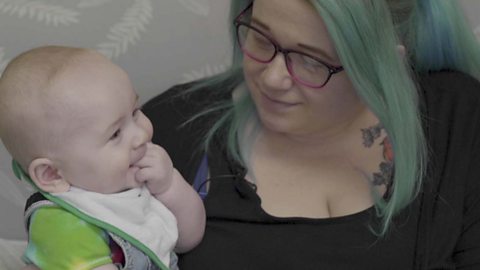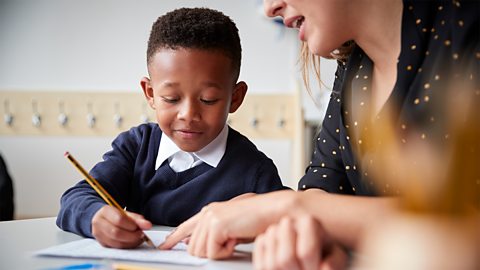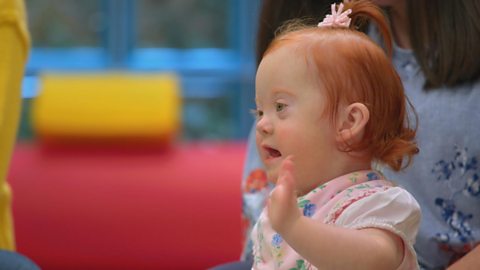You probably spent a lot of time debating the perfect name for your baby and it's something that they're going to hear throughout their lifetime.
But how do babies come to recognise their own name and understand that it refers to them? We caught up with Speech and Language Therapist Janet Cooper to find out.
When do children first start to recognise their names?
‚ÄúIt‚Äôs generally thought children typically begin to recognise their first names between seven and nine months,‚ÄĚ says Janet. However, she thinks there‚Äôs a step along the way where children begin to recognise the pattern of intonation before they fully get to grips with the precise sound of the name‚Äôs syllables. ‚ÄúFor example, my grandson's called Axel. But we all kind of go Ax-el, with an up and down voice. Babies are picking up on the rhythm.‚ÄĚ
Trish (Health visitor)
Robin, hello. Is it baby Robin?
Mum
We went with Robin, I quite like nature-y names so it was kind of something like that. I did have a longer list but it was one of very few that my boyfriend liked so we had to go with that.
Cristina (SLT)
You probably spent a lot of time debating the perfect name for your baby and it's something that they're going to hear throughout their lifetime. At this stage, your baby is noticing their name is a pattern of sounds that they hear everyone make over and over again.
Mum
Robin. Hiya! Hiya!
Cristina
Their brain is working hard to spot sequences of sounds and store them in their memory and importantly your baby is starting to make the connection between hearing the name and getting your attention, something that they love.
Trish
Did you kind of notice when he started to respond to his name?
Mum
Maybe the last few months yeah he has started responding like he'll whirl around and stuff like that and stare at us when he knows we're trying to get his attention. Robin. Hello!
Cristina
It's not just their name that they're tuning into, at around eight months of age, your baby is starting to recognise words that they're hearing a lot and beginning to store them. These sounds are processed in a part of the brain called the auditory cortex. Words that they hear a lot get stored in their long term memory. This involves different parts of the cerebral cortex. Their name is such an important word for your baby. Keep an eye out for how they respond to it.

How do children come to respond to their names?
Janet says that the key to babies learning their name, as with any naming word for objects around them, is to do with repetition.
The more you're using the child‚Äôs name as a label, and they turn towards the sound and recognise ‚ÄėOh, it‚Äôs directed at me‚Äô, the more likely they are to attach that label to themselves.
And the more they respond to their name, the more of your attention they get, which is something babies love and learn from.
Janet recommends chatting in a way that lends itself to using baby‚Äôs name as much as possible. This could mean simply using their name when they‚Äôre not directly facing you, so that they turn their head towards you. ‚ÄúIt's important to use the name to get attention,‚ÄĚ she says. Babies normally begin turning their head towards sound at around 6 months, she says. She also recommends playing and singing songs that involve repetition of baby‚Äôs name. ‚ÄúYou could introduce it with things like ‚Äėmy turn, your turn‚Äô, using baby‚Äôs name in place of ‚Äėyour‚Äô when you're playing and waiting for them to respond to their name with a noise. Otherwise, you could build in their name as part of a song, for example, singing the ‚ÄėHello‚Äô song.‚ÄĚ
A lot of parents say when they get to about 2, they stop turning around to their name because they don't want to. They think ‚ÄėI can ignore that‚Äô and get on with what they‚Äôre doing!


Why is it important that children understand their names?
Understanding their name is key to a child’s sense of identity says Janet. It also helps direct a child’s attention which leads to better understanding of what's going on in the world around them.
Not only this, but if it‚Äôs not clear that a child understands their name, it can have a knock-on effect for other communication skills, Janet warns. ‚ÄúI worked with a little boy with an Asian name - the school reported that he didn't understand anything, he wasn‚Äôt even responding to his own name. But when I assessed him, I knew that he could understand. I brought together his teacher and his mum, and I asked the mum to pronounce his name - she pronounced it completely differently to how it was being said in the classroom. He hadn‚Äôt picked up that it was the same label because they weren't pronouncing it in the same way.‚ÄĚ
What names are easiest for children to say?
The easiest names for children to learn to say, as with any of babies‚Äô early words, involve sounds made with the front of the mouth, says Janet. ‚ÄúThe easiest words babies can make involve ‚Äėlips together‚Äô sounds or sounds where you put the tongue on the bumpy bit behind the top teeth,‚ÄĚ Janet tells us. ‚ÄúIf somebody says a word like ‚Äėmama‚Äô, babies can actually see how they're making that sound as they make it. Sounds made further back in the mouth are harder to recognise.‚ÄĚ
So, names using these sorts of letter sounds are much easier for children to start using themselves. ‚ÄúIf parents named their children based on what would be easiest for them to say, there‚Äôd be a lot of Bobs around!‚ÄĚ, says Janet.
TV companies making cartoons are very clever with naming. Names like Peppa Pig or Postman Pat use sounds that are made with lips together at the front of the mouth. That’s why children love those names and can start to say some of them quite early on.


When do children understand their names written down?
While children hear their name from birth, it‚Äôs not until much later that they become used to seeing their name written down and begin to link the written name with themselves too. ‚ÄúIt depends where they're at with literacy, really, but most wouldn't understand their written name until around four,‚ÄĚ says Janet.
According to Janet, much like a spoken word, understanding written words like names involves making connections between the visual set of written symbols and the object they refer to. ‚ÄúIf you think about writing, it's another set of symbols used to stand for something else. So what children need is that firm understanding of the spoken symbol what it represents. Once they‚Äôve got that idea, they can link the written label to the spoken symbol as two ways to refer to the same thing.‚ÄĚ
As with spoken names, the more children see their name written down and are introduced to it along with the sound of their name, the more likely they‚Äôll be to make the connection with themselves. ‚ÄúAnd it's just like spoken language, the more experience you've had of written words used alongside the real object or picture the more likely you are to make the connection. For example showing the word 'cat' when there is a cat present helps the child make links between the object, the word and the written text.‚ÄĚ







